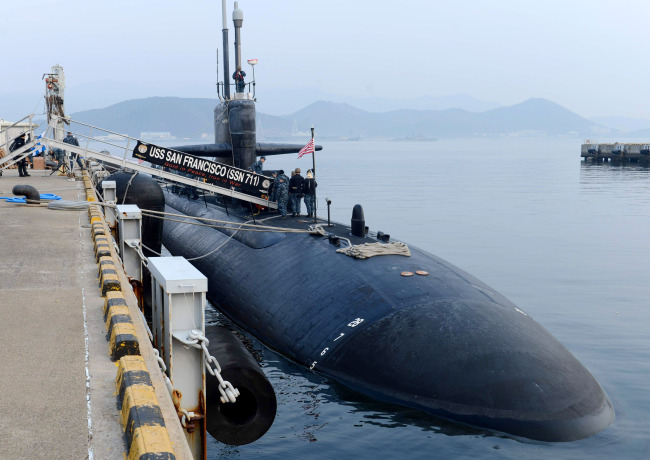U.S. sub, cruiser arrive in S. Korea
Anti-sub drills scheduled for next week as N.K. moves for nuclear test
By Korea HeraldPublished : Feb. 1, 2013 - 20:49
A U.S. Navy nuclear-powered submarine and Aegis-equipped cruiser have arrived in South Korea in what appears to be a show of force against North Korea pushing for a third nuclear test despite international criticism.
The USS San Francisco, a 6,927-ton Los Angeles-class submarine, and USS Shiloh, a 9,800-ton guided-missile cruiser, are now in Jinhae, South Gyeongsang Province, and Busan, respectively. The top-of-the-line vessels will participate in the allies’ antisubmarine drills next week, officials said.
“As the allied navies have set the plan to stage the antisubmarine maneuvers early next week in the East Sea, we are now in consultation to finalize the detailed schedule. The vessels are now on standby at the ports,” an official at Seoul’s Joint Chief of Staff said, declining to be named.
The USS San Francisco, a 6,927-ton Los Angeles-class submarine, and USS Shiloh, a 9,800-ton guided-missile cruiser, are now in Jinhae, South Gyeongsang Province, and Busan, respectively. The top-of-the-line vessels will participate in the allies’ antisubmarine drills next week, officials said.
“As the allied navies have set the plan to stage the antisubmarine maneuvers early next week in the East Sea, we are now in consultation to finalize the detailed schedule. The vessels are now on standby at the ports,” an official at Seoul’s Joint Chief of Staff said, declining to be named.

Both Seoul and U.S. officials appear cautious about linking the ships’ participation in the upcoming drills to the North’s preparation for the atomic test, for fear that it could needlessly provoke China, the sole major ally and patron of the reclusive state.
“The ships have nothing to do with the North’s nuclear issue. The drills in which they will participate are part of regular, annual joint exercises,” a Seoul official told media on condition of anonymity.
During his visit to the USS San Francisco in Jinhae on Thursday, Joint Chiefs of Staff Chairman Gen. Jung Seung-jo said that the South Korean military was keeping close tabs on North Korean movements, cautioning against the North’s “deceptive” military strategy.
“There has been a flurry of activity near the test site. I can’t elaborate on it, but we are watching them closely to find out if these are part of its deceptive strategy or if it is really doing that to prepare for the test,” he told reporters.
“As the preparations are proceeding underground, there is some limit for us to grasp what is happening there. But we are ready around the clock, believing that the test could be carried out at anytime.”
Some reports raised the possibility that the aircraft carrier USS George Washington, whose home port is the Yokosuka Naval Base in Japan, could also join the forthcoming antisubmarine maneuvers to send a clear warning message to Pyongyang.
Seoul officials believe the North has already completed all necessary preparations for the nuclear test at the Punggye-ri site in the country’s northeast, where it carried out previous atomic tests in 2006 and 2009.
This week, the North installed pieces of equipment to gauge radioactivity that could result from the nuclear detonation. It has also put a cover at the entrance of the underground test site to avoid the satellite monitoring by the U.S.
“The cover appears to be a measure to prevent their preparation activities, which are now in their final stage, from being exposed to the outside audience,” a government source said.
Other observers said that the cover could be intended to deceive Seoul and Washington, stressing that the allies should remain cautious in their joint intelligence analysis.
Amid the North’s push for the provocative test, Seoul is considering pushing for tougher sanctions in tandem with the international community. Officials indicated that the sanctions under consideration would be tougher than those entailed in U.N. Resolution 2087, which condemned the North’s December rocket launch.
Some observers said that possible sanctions for South Korea include launching massive military drills with the U.S. near the peninsula in a show of force against the North; deploying strategic ballistic, cruise missiles capable of surgically striking the North’s nuclear and missile bases; and seeking to bolster global efforts to intercept suspicious North Korean vessels.
The USS San Francisco belongs to the U.S. Navy’s Submarine Squadron 11 in Arizona. It measures 110.3 meters in length and 10.1 meters in width. It is equipped with high-tech weapons systems such as Tomahawk missiles.
Measuring 173 meters in length and 16.8 meters in width, the USS Shiloh is also equipped with top-of-the-line arms such as Harpoon, Tomahawk and SM-3 missiles and torpedoes. It belongs to the 7th Fleet in Yokosuka, Japan.
By Song Sang-ho & Joint Press Corp (sshluck@heraldcorp.com)
-
Articles by Korea Herald


![[H.eco Forum] H.eco Forum calls for transition to clean, carbon-free energy](http://res.heraldm.com/phpwas/restmb_idxmake.php?idx=644&simg=/content/image/2024/05/22/20240522050668_0.jpg&u=20240522175145)
![[Exclusive] LACMA admits it needs further research on donated Korean paintings](http://res.heraldm.com/phpwas/restmb_idxmake.php?idx=644&simg=/content/image/2024/05/22/20240522050568_0.jpg&u=20240523001632)


![[Up close in Yeouido] Trump hinting at US troop removal in South Korea ‘election-time talk’](http://res.heraldm.com/phpwas/restmb_idxmake.php?idx=644&simg=/content/image/2024/05/21/20240521050695_0.jpg&u=20240522173622)
![[Bridge to Africa] Africa-Korea partnership: Why it matters for future](http://res.heraldm.com/phpwas/restmb_idxmake.php?idx=644&simg=/content/image/2024/05/22/20240522050681_0.jpg&u=20240522182351)
![[Herald Interview] Korean adoptees embark on journeys to find roots](http://res.heraldm.com/phpwas/restmb_idxmake.php?idx=644&simg=/content/image/2024/05/22/20240522050754_0.jpg&u=20240522190539)
![[Graphic News] Medical tourists visiting Korea reach record high](http://res.heraldm.com/phpwas/restmb_idxmake.php?idx=644&simg=/content/image/2024/05/21/20240521050794_0.gif&u=20240523171313)









![[Today’s K-pop] Blackpink cinches gold certification in UK](http://res.heraldm.com/phpwas/restmb_idxmake.php?idx=642&simg=/content/image/2024/05/22/20240522050738_0.jpg&u=)